Music production is an intricate blend of rhythm, constant evolution, and intuition, not to mention unmatched dedication.
As a music producer, it’s crucial to master both the creative nuances and the technical aspects of the craft to create music that stands out significantly.
Producing tracks that genuinely resonate with listeners demands expertise, passion, and a touch of genius.
Knowing how to infuse your own music with unique elements (while also understanding the mechanics behind a great mix) sets the professionals apart from the amateurs.
That’s why we’re diving deep into the world of music production.
We’ll be breaking down how to make music that truly shines and puts the competition to shame.
In today’s article, we’ll be covering:
- How to make music that resonates & captures hearts ✓
- Setting up your home studio for maximum results ✓
- Crafting beats that blow the competition away ✓
- Music theory essentials in hip-hop ✓
- Vocals that breathe life into your track ✓
- Mixing and mastering: The final polish ✓
- Music promotion strategies to get your music out there ✓
- Professional tips, tricks, and tricks ✓
- Much more on how to make music that tops the charts ✓
By the end of this article, you’ll have the tools and knowledge to produce music that captivates and resonates.
Plus, with some expert music production tips, tricks, and secrets, you’ll be well on your way to establishing a significant footprint in the music industry.
So, let’s dive in…
Table of Contents
- Introduction to Modern Music Production
- Starting Your Music Production Journey
- Crafting the Perfect Hip-Hop Beat
- Delving into Music Theory for Hip-Hop Producers
- Vocals: The Soul of Your Track
- Mixing and Mastering: Giving Your Track the Pro Touch
- Bonus: Leveraging Streaming Platforms like Apple Music & Spotify
- How to Make Music: Final Thoughts
Introduction to Modern Music Production
Music production has always been captivating, evolving rapidly to incorporate new sounds and technologies.
As we delve into the intricacies of making music, let’s start by understanding where it all began.
-
The Evolution of Music Production
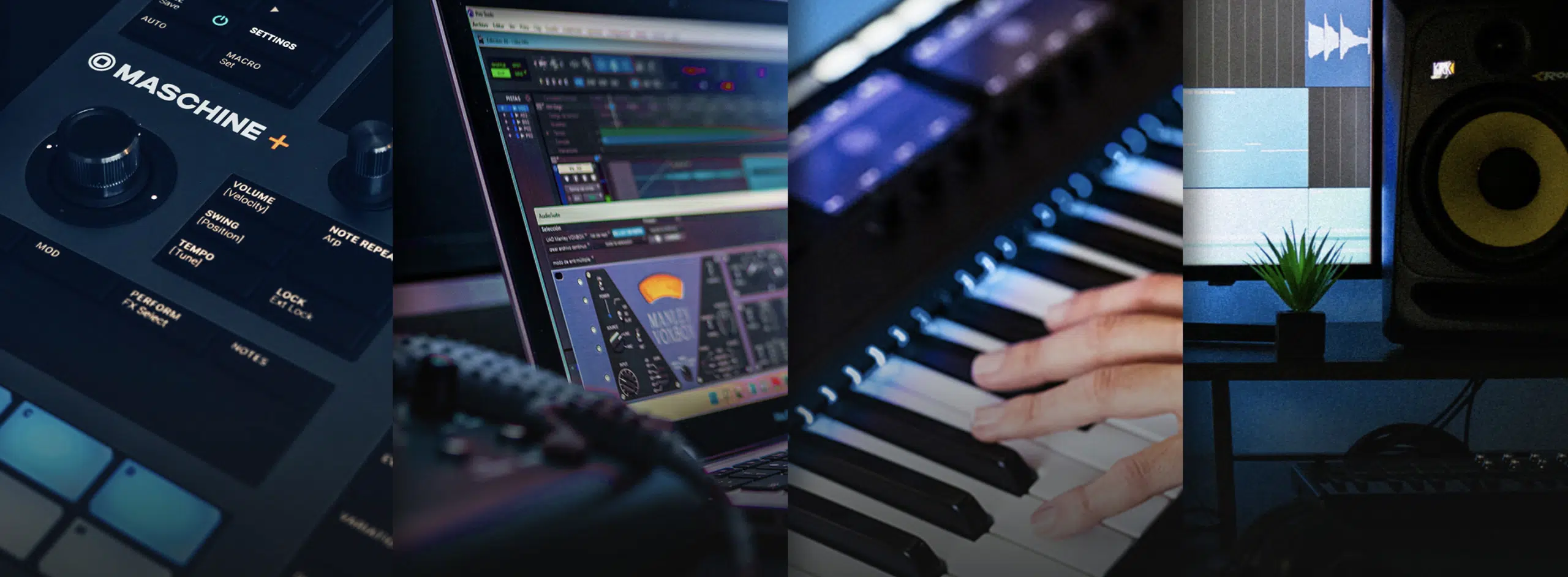
From the age of analog tape machines to the revolutionary digital age, how we produce music has undergone a massive transformation.
Making music became easily accessible with the emergence of software, sparking a new era of digital music production.
As the digital audio workstation (DAW) started becoming popular, music producers had a platform to craft their own music, otherwise impossible.
Gone were the days when one needed a full-fledged studio 一 now, an efficient laptop and some software were sufficient.
Digital signals and high-quality recording then became the new normal.
Meaning, many musicians from around the world could now:
- Manipulate different sounds
- Craft full tracks
- Master songs without leaving their home studio
With the rise of software instruments, producers could emulate almost any sound imaginable, from an electric guitar to a complete drum kit.
This accessibility gave producers like us, who were not restricted by physical instruments or recording equipment, the opportunity to make legendary tracks.
Now, a music producer has way more freedom in the modern era, which we’ll discuss in the following section.
-
Role of a Music Producer in the Modern Era
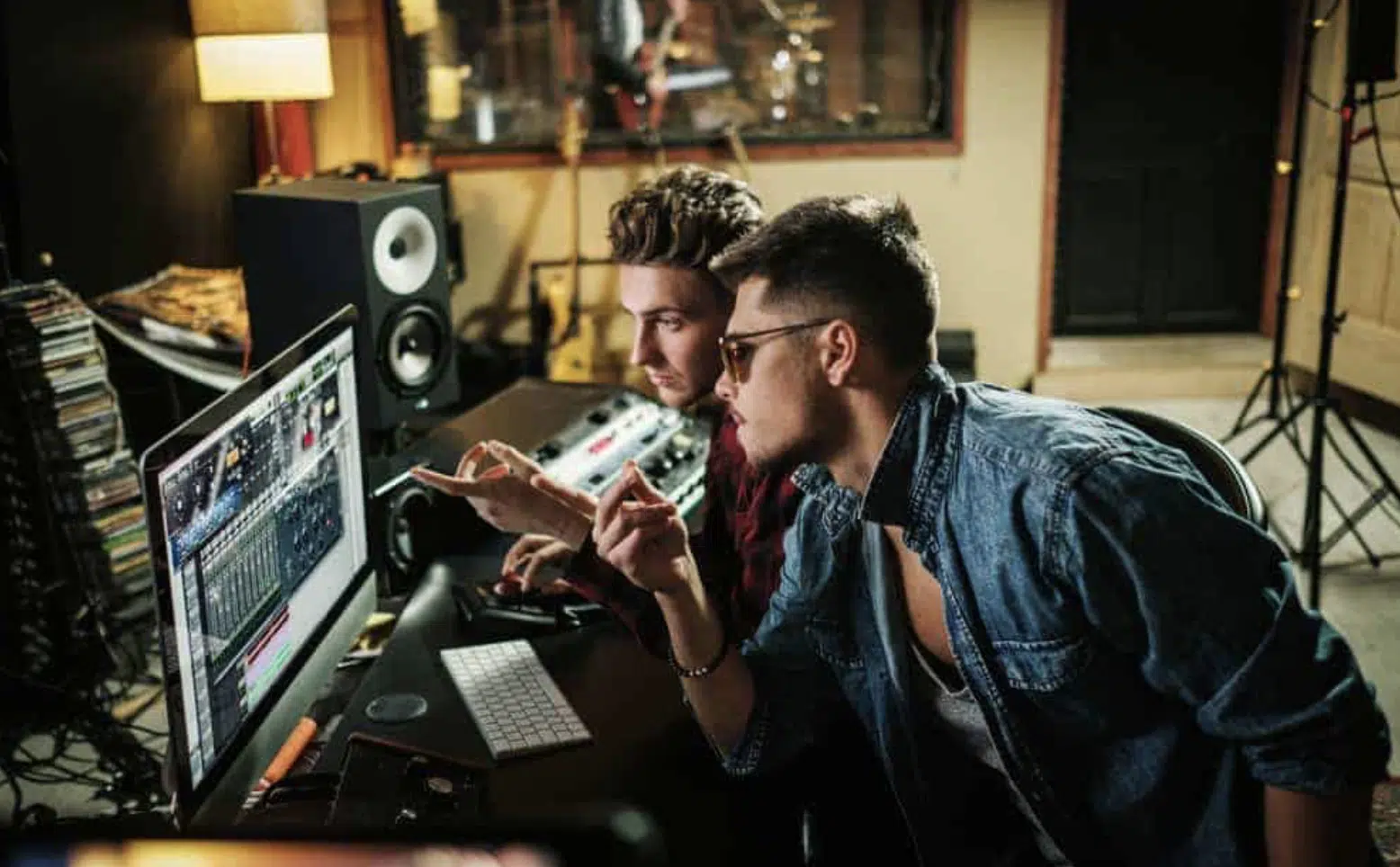
The role of a music producer in the modern era has shifted from the person behind the console to a vital asset in the entire song-creation process.
As a music producer, you must be involved with:
- Songwriting
- Arranging
- Mixing and mastering
- Incorporating audio effects
- Polishing and promoting
- Getting super creative to stand out
In the age of streaming services and music online, a producer’s influence can often be the difference between a track getting a few plays or going viral.
They can shape the sound of an entire track, ensuring it sounds good across all streaming platforms.
Additionally, music producers today often wear multiple hats.
You might be mixing one day, mastering another, and creating beats on another, as the rise of the home studio has allowed you to take control of the entire process.
Collaboration is also key in today’s music industry.
Producers often work with other artists, singers, and even other producers to create a fresh and unique sound.
By collaborating, you can expose yourself to different genres (like pop, hip-hop, trap, EDM, etc.) and musical ideas, constantly evolving in your music production journey.
Starting Your Music Production Journey
Diving into the world of music production can be both thrilling and overwhelming.
With various tools and software available, learning how to make music that captures and resonates is a little more challenging.
So, let’s break down the first steps of how to make music in this fast-paced digital world.
-
Choosing The Perfect Digital Audio Workstation (DAW) For You
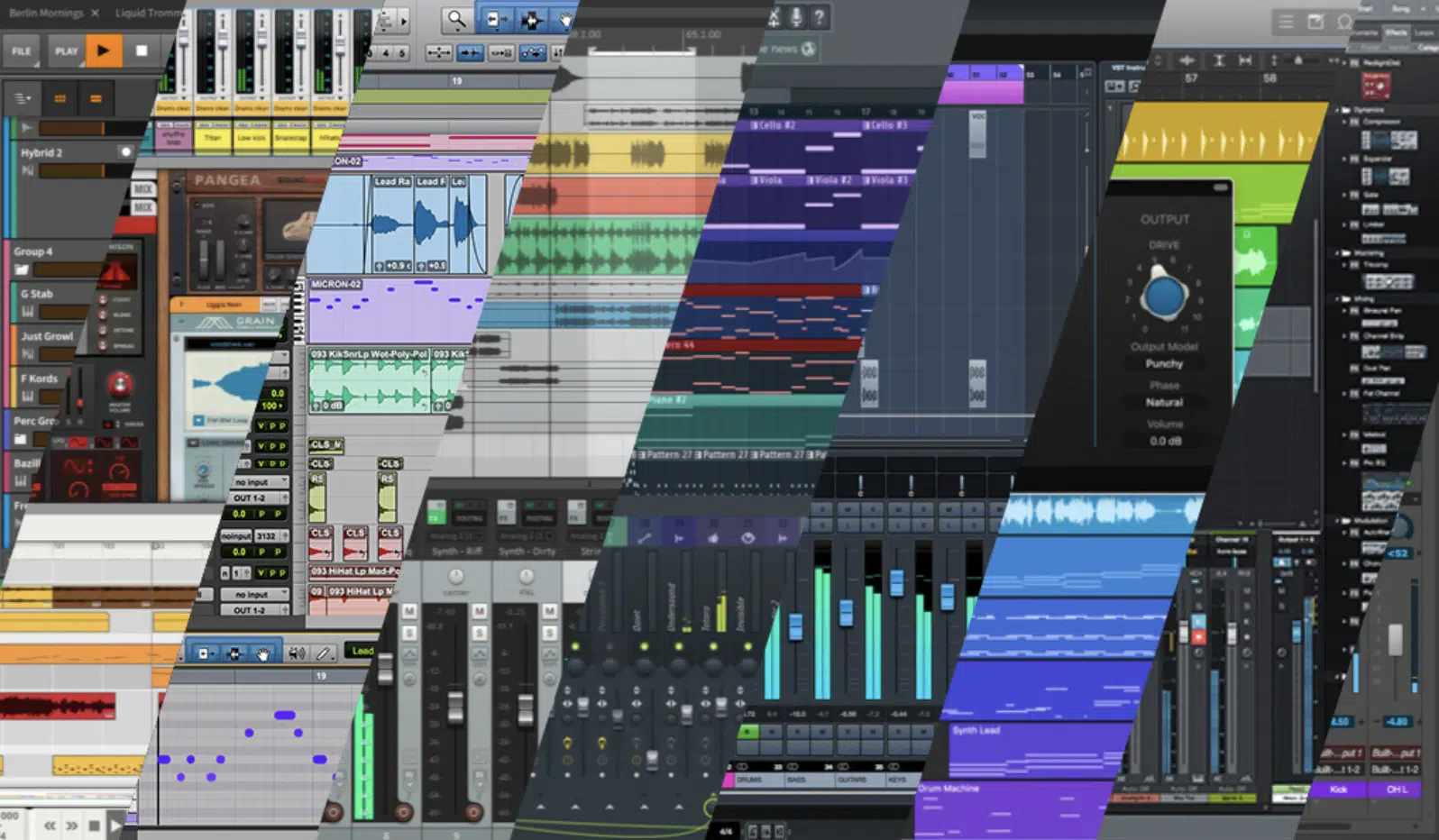
Your DAW is your primary tool, the canvas where you’ll produce music, discover your signature sound, and refine your craft.
So, picking the right one for you is essential in how you produce music and develop an ideal music production workflow.
NOTE: FL Studio, Ableton Live, and Pro Tools are among the top choices for hip-hop producers.
While they all excel in music production, each has unique features catering to different aspects of the beat-making process.
FL Studio, for instance, is renowned for its user-friendly interface and is a favorite among hip-hop producers for crafting beats.
Its step sequencer makes drum programming a breeze, which is essential for creating those infectious trap rhythms and learning how to produce music that pops.
On the other hand, Ableton Live shines in live performances and offers seamless integration of sample packs/sample libraries.
Its Session View facilitates the straightforward arrangement of different sounds 一 perfect for experimenting and developing an entire song structure on the fly.
Speaking of, if you’d like to learn all about the most influential song structures, we’ve got you covered.
When learning how to make music that can potentially top the charts, you must select one that resonates with your unique style.
This way, you’ll find a solid groove that allows you to get extra creative.
-
Setting up Your Home Studio: How To Make Music Comfortably

Having your own music production space is vital.
Therefore, your home studio should be a sanctuary where creativity flows, and your musical idea can flourish.
Start with the basics: a reliable computer, a pair of studio monitors for a balanced sound, and a good pair of headphones are a good starting point.
Remember, it’s not always about having the most expensive gear in your home studio when you’re learning how to make music.
It’s more about understanding your equipment and optimizing its use.
You don’t need to spend an insane amount of money to produce music that emulates your most favorite songs.
Acoustic treatment can be an added advantage, whether recording digitally or playing your song live.
Simple foam panels can dramatically improve sound quality 一 ensuring that you hear a true representation of your mix.
This is especially crucial during the mixing and mastering stages of music production.
Organizing your workspace and having a clutter-free environment is also vital.
Having dedicated spaces for your MIDI controller, drum machines, or electric guitar can streamline your workflow.
This will ensure you remain productive when inspiration strikes and produce music that captivates the masses.
-
Importance of an Audio Interface & Studio Monitors
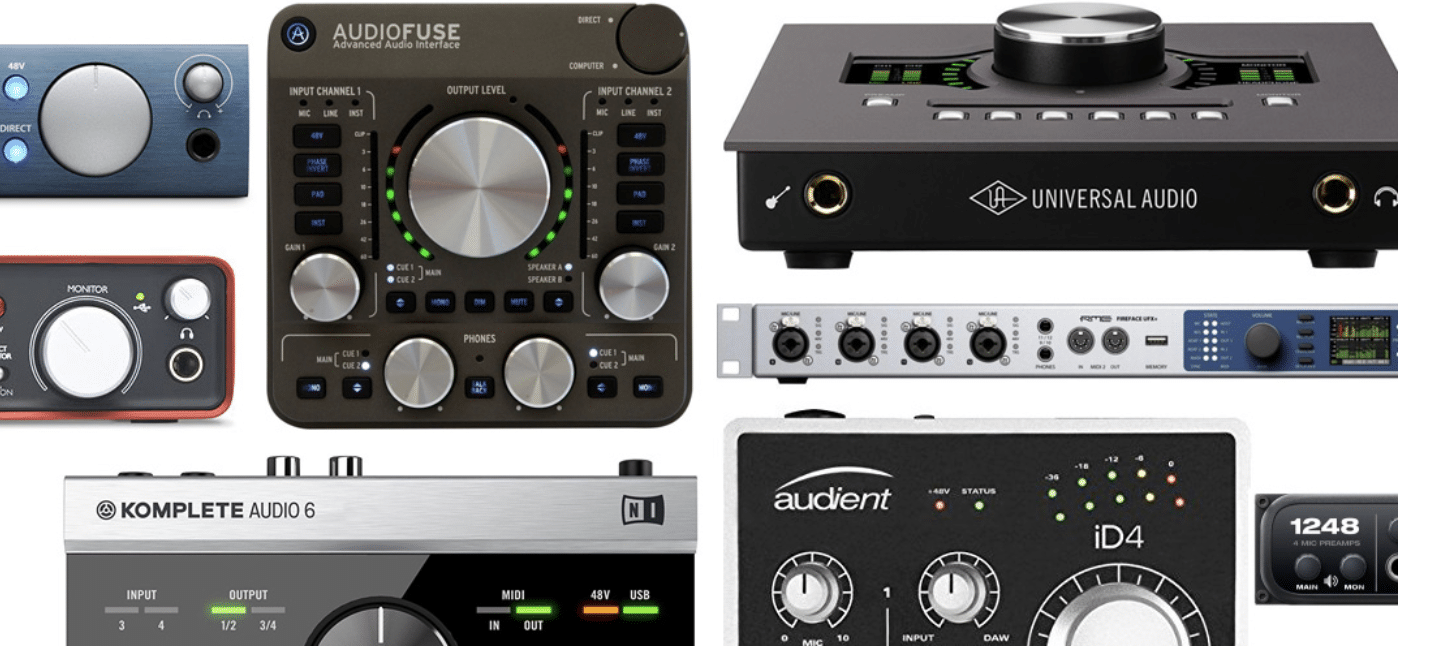
An audio interface acts as the bridge between your computer and everything else.
It converts analog signals (like vocals or live instruments) into digital signals your digital audio workstation can process.
Whether you want to record vocals or an electric guitar, the clarity an audio interface offers is unmatched.
Studio monitors give an accurate representation of your sound.
Unlike regular speakers, which might boost certain frequencies, studio monitors provide a flat response.
This ensures that your finished song translates well across various listening devices.
Proper positioning of studio monitors (an equilateral triangle with your listening position) is essential.
This setup ensures an optimal listening experience 一 allowing you to make informed decisions during the mixing stage.
NOTE: Brands like Focusrite and PreSonus offer interfaces that provide high-quality recording without breaking the bank.
Learning how to create music that keeps your listeners engaged is a lifelong journey, so start by familiarizing yourself with the most popular brands and styles.
-
Selecting the Right Software Instruments & MIDI Controller
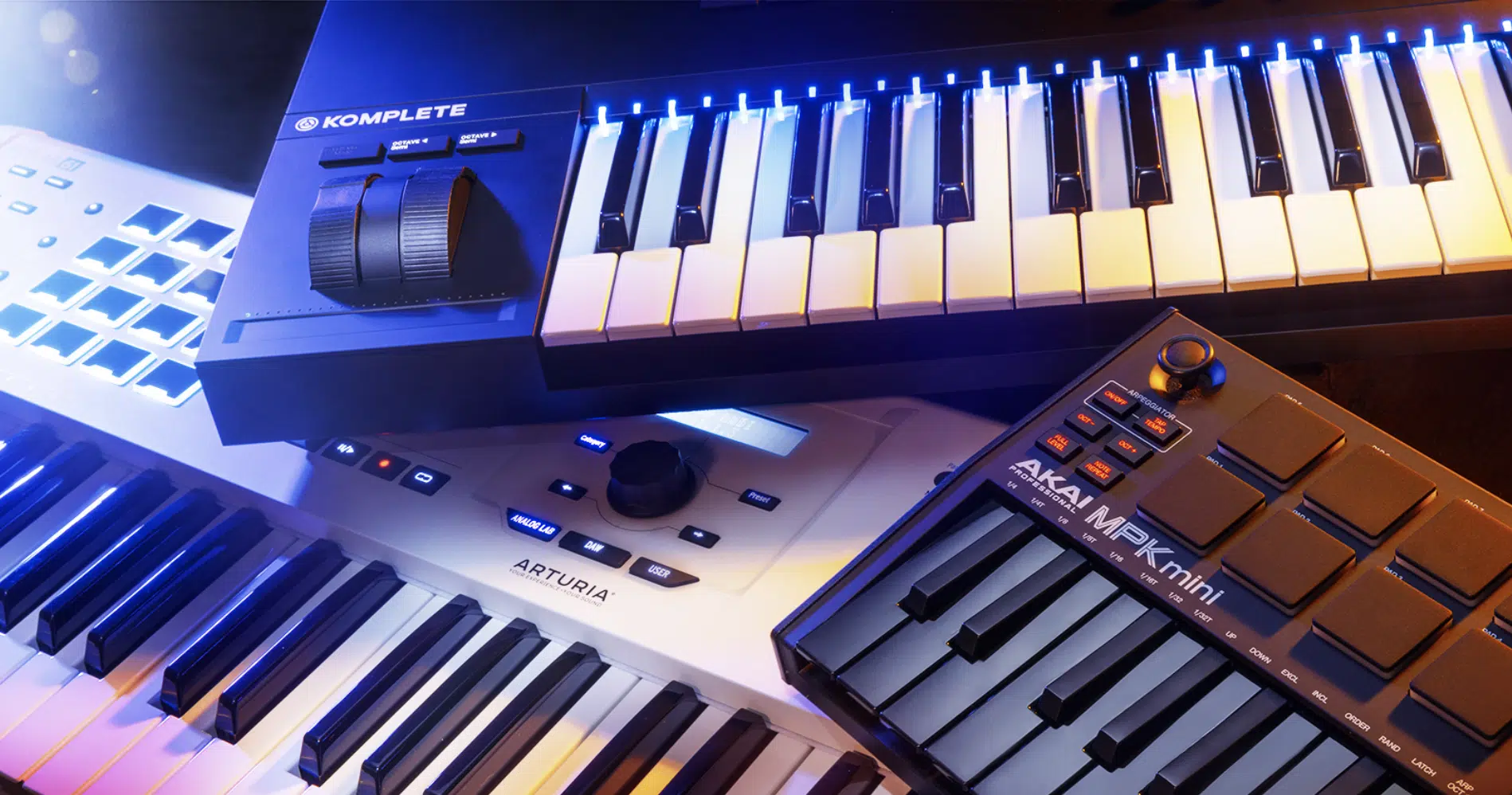
When you’re learning how to make music that doesn’t get lost in the crowd, you’ll need to be familiar with software instruments and MIDI controllers.
Software instruments, or VSTs (Virtual Studio Technology), emulate the sounds of actual instruments.
From mesmerizing pianos to gritty synthesizers, a software instrument can expand your sonic palette and allow your music to stand out.
If you’re learning how to make music that doesn’t just capture people’s attention but leaves an impression to be desired, a software instrument can excel in this process.
Popular VSTs in the hip-hop community include:
These powerhouses offer a plethora of sounds; perfect for when you want to create music that includes unique melodies and hard-hitting basslines.
A MIDI controller is your physical connection to the digital world and your best friend when learning how to make music that doesn’t get lost in the mix.
It allows you to play software instruments in real time 一 adding a human touch to your digital productions.
Brands like Akai and Novation offer controllers that are both robust and sensitive to touch.
Integrating a MIDI controller streamlines your workflow and helps you create a full track with intriguing/unique patterns and effects.
With tactile knobs, pads, and keys, you can adjust parameters on-the-fly, capture a chord progression, and drum out patterns.
This will make the process of making music way more intuitive.
Crafting the Perfect Hip-Hop Beat
Once you’ve established your music production foundation, it’s time to dive into the essence of hip-hop: the beat.
A captivating beat is vital when you want to produce music that resonates and leaves a lasting impression.
Let’s discuss a few of the ways you can achieve this and excel at this process.
-
Sampling: Breathing Life Into Your Tracks
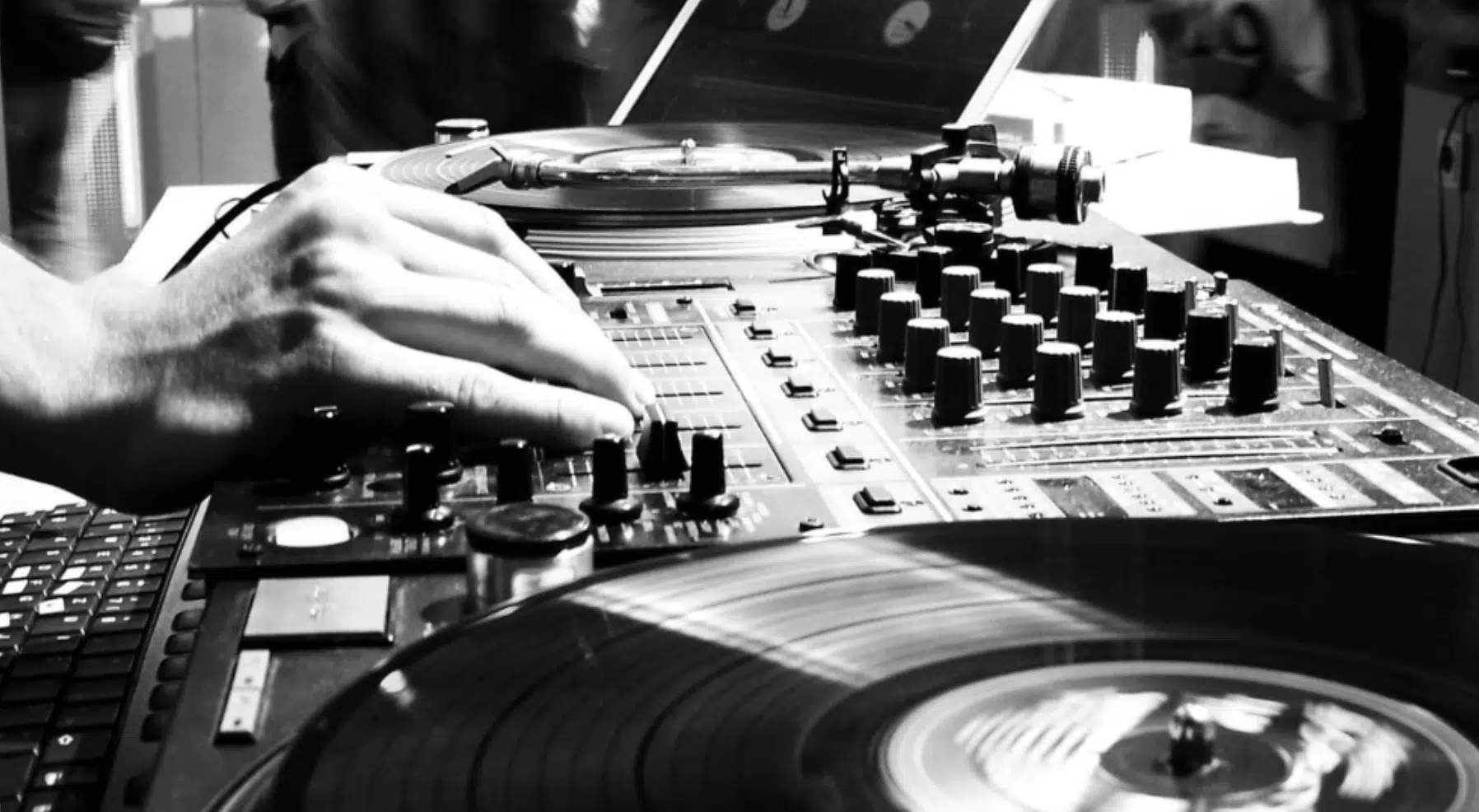
Sampling is one of the most pivotal cornerstones of hip-hop.
By extracting pieces from existing music, you can incorporate diverse musical ideas and sounds into your own music.
When you want to produce music that brings that vintage vibe to your modern tracks, try sampling:
- Vinyl records
- Old soul tracks
- Sounds from nature (foley sounds)
- Etc.
For instance, Kanye West’s “Bound 2” heavily samples soul tracks, creating a nostalgic yet fresh soundscape.
Tools like Serato Sample or Native Instruments’ Maschine can help you chop, pitch, and rearrange samples.
This will help your creativity to flourish and evolve.
Remember, while sampling can give your music a unique edge, always be mindful of the dreaded copyright laws.
Some of the most incredible music in the hip-hop genre has faced legal challenges over uncleared samples.
Speaking of samples, if you’re looking for the absolute dopest free sample libraries of 2023, we’ve got you covered.
-
Drum Patterns, Drum Machines, and Creating That Ideal Groove
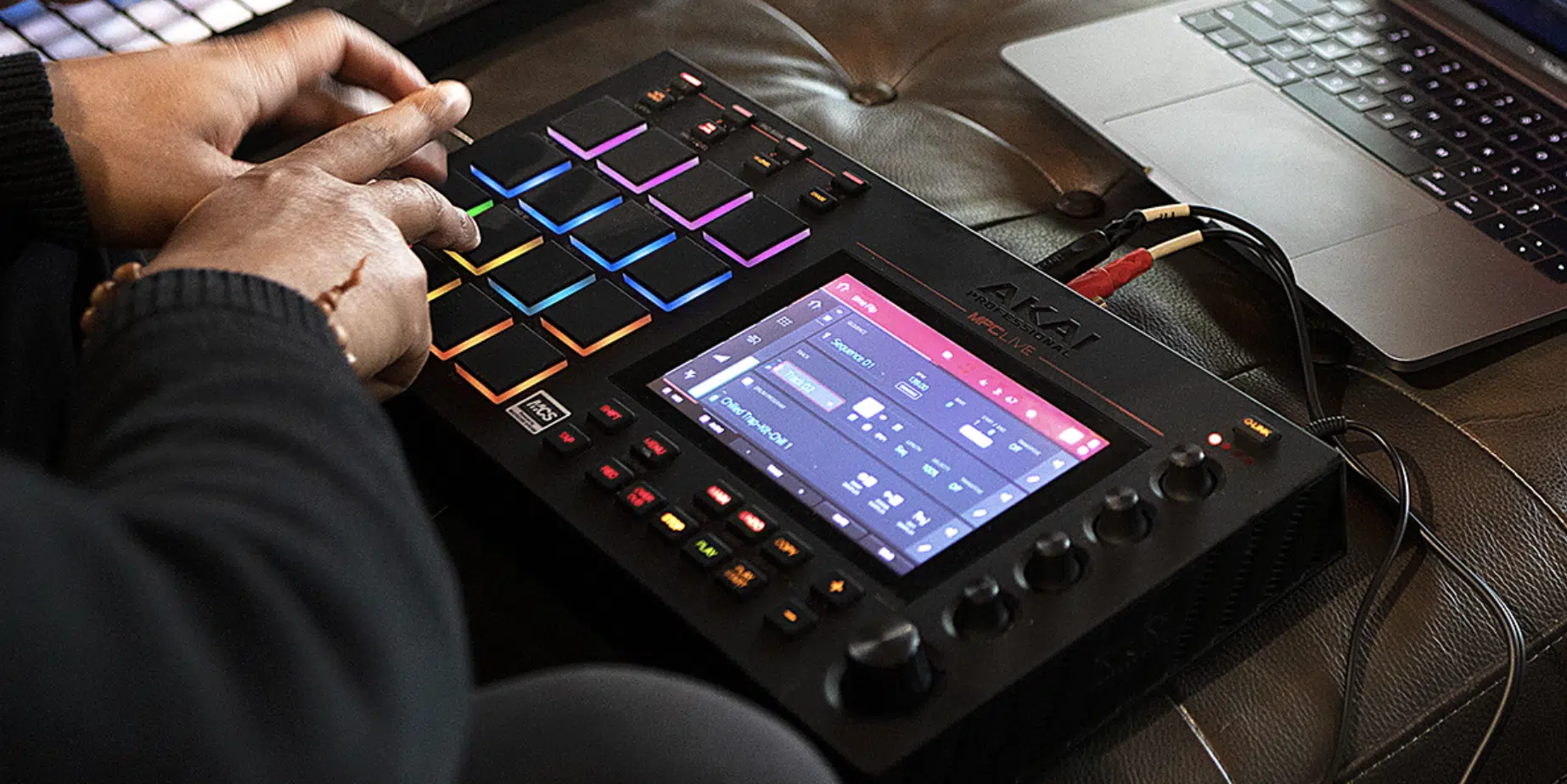
Hip-hop beats thrive on rhythm, and a catchy drum pattern can be the backbone of how you make music that sticks.
808s have become synonymous with trap music, providing deep, pulsating basslines.
Producers like Metro Boomin often use 808s to create tracks that rumble any speaker system and emotionally resonate with audiences worldwide.
Drum machines (such as the Roland TR-808 and Akai MPC) have played pivotal roles in hip-hop’s evolution.
While drum machines began as physical hardware, many are now available as software plugins.
Crafting intricate hi-hat patterns or mesmerizing snares can set your track apart.
Music production software like FL Studio offer a step sequencer.
Step sequencers allow you to visually lay out drum hits 一 ensuring the groove feels just right.
PRO TIP: When you produce music, you have to get creative, and that’s where layering comes in, so try layering different drum sounds, which can add depth to your beat.
For instance, layering a snappy snare over a resounding clap can result in a punchy hit that cuts through the mix.
-
Creating Hard-Hitting Basslines
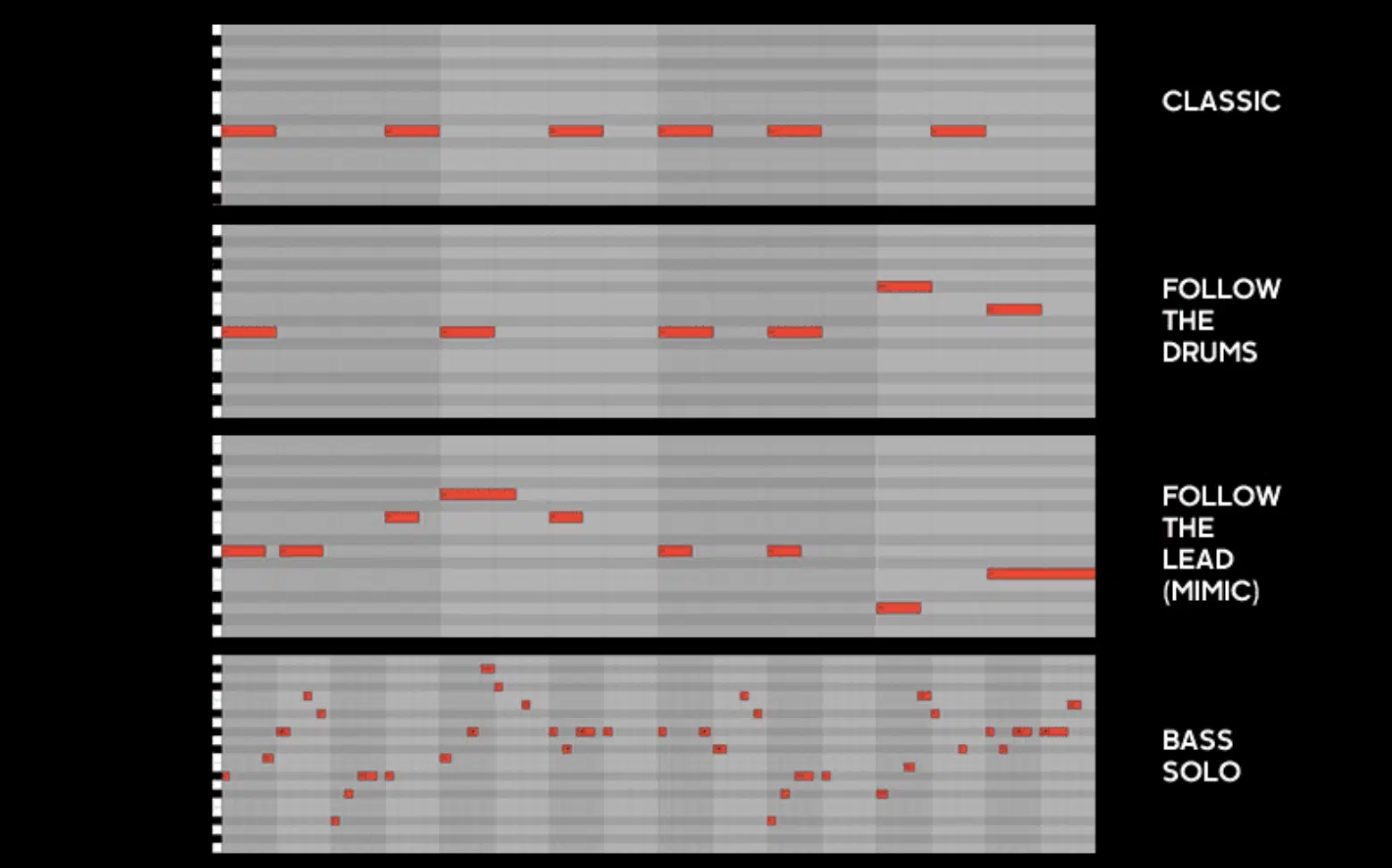
The bassline is the heartbeat of any successful hip-hop or trap track.
A hard-hitting bassline can successfully provide:
- Low-end energy
- A captivating element
- The song’s emotional tone
Many hip-hop tracks, especially in trap, utilize sub-bass frequencies.
Artists like Travis Scott have tracks where the bass plays a melodic role, making the track instantly recognizable and addicting.
If you want to learn how to make music that tops the charts, then learning how to integrate this same technique can help.
VSTs like Serum or Massive are favorites for crafting these basslines.
Their extensive sound design capabilities can help you sculpt the perfect bass sound that feels powerful and melodic.
PRO TIP: Side-chaining your bass to your kick drum ensures they don’t clash 一 giving a pulsing effect that can make your track breathe and groove simultaneously.
-
Audio Effects: Making Your Music Stand Out
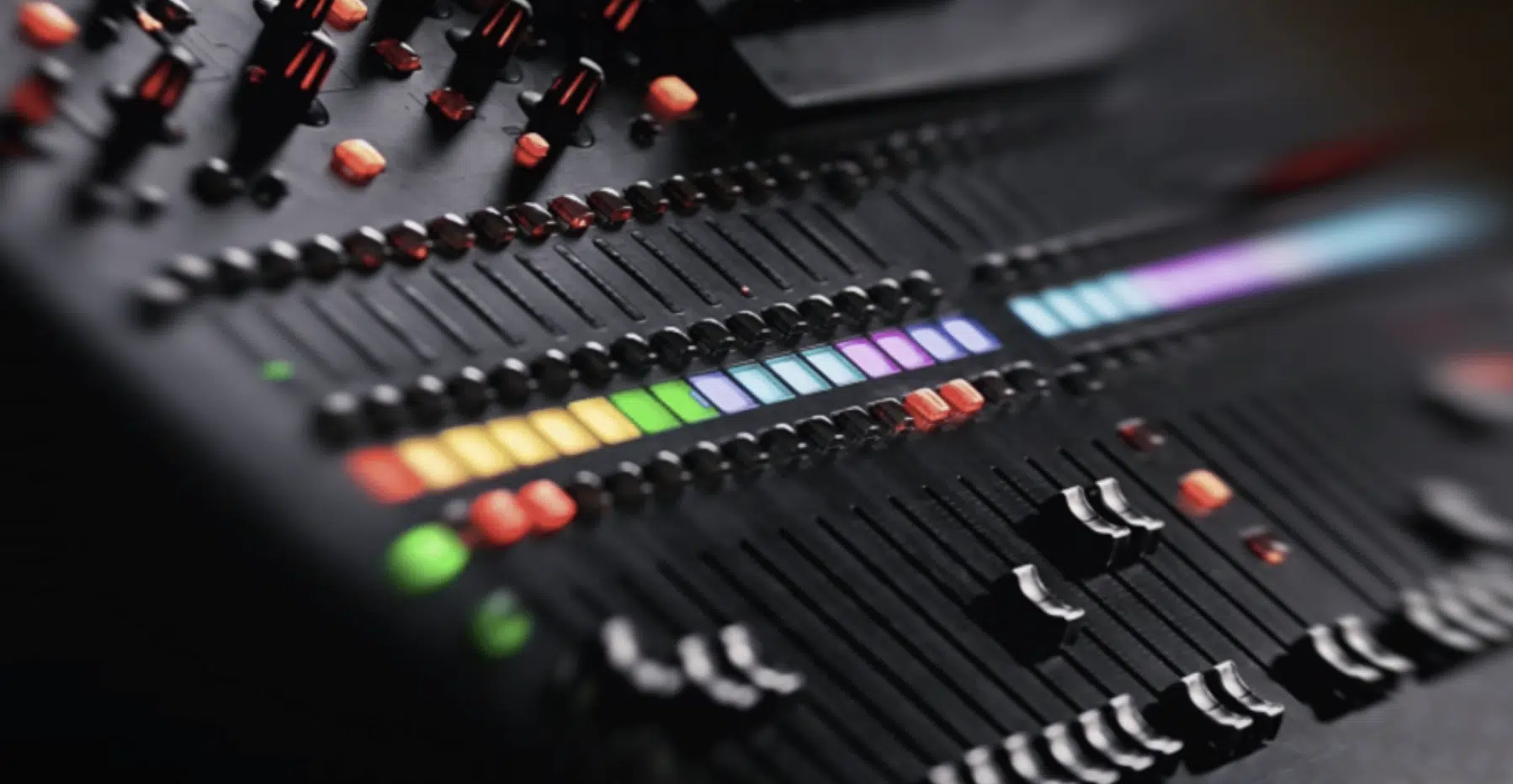
Before diving into complex sound design, start with the audio effect essentials, such as reverb and delay.
Whether creating an ethereal atmosphere in pop music or adding depth to a hip-hop beat, you must understand effects.
Modulation effects are paramount in producing music with a rich texture.
Specific modulation effects can turn a simple chord progression into a swirling soundscape, such as a:
For example, electronic music often uses chorus effects to give synths a lush, wide feel.
Dynamics and distortion (like compressors, limiters, and gates fall under dynamics) can make your drums punchier 一 ensuring your beats stand out.
On the other hand, distortion isn’t just for rock music.
In hip-hop, subtle distortion can add warmth and character to a bassline or even vocals.
EQ (equalization) is pivotal whether you’re carving out low-end rumble, boosting a vocal’s clarity, or ensuring your kick and bass coexist peacefully.
So, if you’re going to successfully learn how to make music that bumps, EQ is key.
Specialized Effects: With advancements in music production, many unique plugins and effects have surfaced.
Granular synthesis, spectral processing, and auto-tune (think of how prevalent it is in hip-hop) can be game-changers.
Staying updated and experimenting with these can give your music an edge.
NOTE: While it’s enticing to stack effects, moderation is vital, as it’s all about enhancing, not overshadowing.
With a good mix of creativity and technical know-how, audio effects can truly make your music distinct and help you learn how to make music that shakes the music industry.
Delving into Music Theory for Hip-Hop Producers
Even in the digital age, understanding Music Theory remains a pivotal part of the music production journey.
This way, you can efficiently break the rules, as you’ll know them like the back of your hand.
Let’s uncover the layers of music theory specifically for hip-hop.
-
Chord Progressions: Making Your Melodies Unforgettable

At the heart of every memorable hip-hop track is a chord progression that evokes emotion, enchants, and reels your listeners in.
A chord progression is a sequence of chords that form the harmonic backbone of your track.
Understanding basic chord progressions and how to produce a unique chord progression from scratch can significantly enhance the quality of your music.
The II-V-I chord progression or the I-IV-V chord progression are popular progressions that have been the foundation of countless hits across different genres.
In hip-hop, minor chords often dominate 一 giving tracks a moody or introspective feel…
Think of the haunting chord progressions in Eminem’s “Stan” or the melancholy progression in Post Malone’s “Circles.”
Tools like Scaler or Captain Chords can assist you in crafting and identifying chord progressions.
Yes, even if you’re not a music theory master quite yet.
PRO TIP: Inverting chords, or adding sevenths and ninths can add complexity to your music, making your beats pop.
So, when you’re first learning how to make music, music theory should be your first step (even if you break all the rules later).
-
Harmonic Structure & Its Influence in Hip-Hop
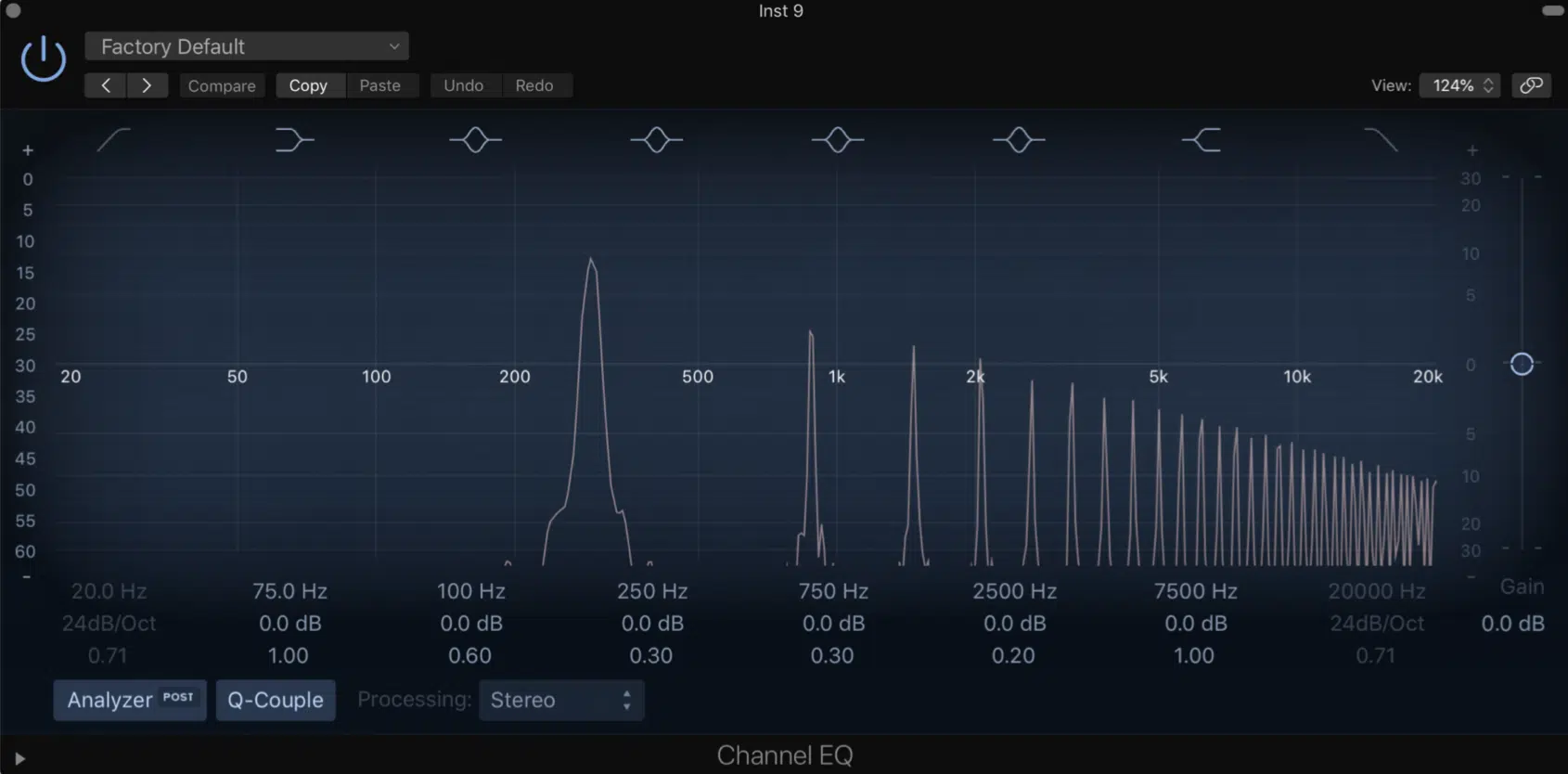
Harmonic structure refers to how chords and melodies interact; in hip-hop, this can make or break the vibe of a track.
An iconic example is Dr. Dre’s use of simple but effective harmonies, like in “Still D.R.E.”
The melodic line plays perfectly with the underlying chords, successfully creating a timeless sound (crucial to staying relevant).
Counter-melodies, where a secondary melody plays against the main one, can add depth.
Many musicians (especially in Trap tracks) utilize this 一 often with a high-pitched instrument playing against a deeper melody.
Synths, pianos, or the human voice can introduce harmonic elements, as each different element adds texture.
So, selecting the right one can define the sound of your own music.
Therefore, you should always experiment and find your signature sound, as you’ll need to be instantly recognizable.
Otherwise, people will not remember you as quickly.
Whether it’s your first track or your 100th finished track, finding and improving on your signature style will help set your music apart and get it the recognition it deserves.
-
Song Structure: Crafting a Hit (From Start to Finish)
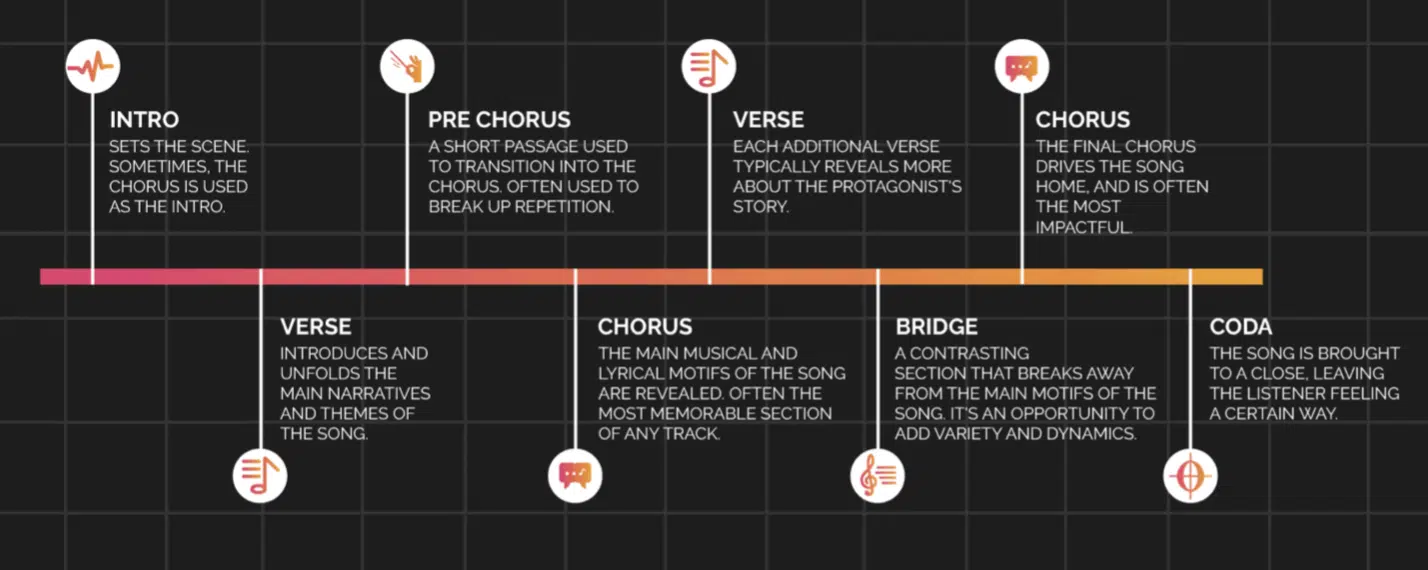
When learning how to make music, structure is the outline of your song, guiding the listener through its different sections.
Most hip-hop tracks follow a verse-chorus-verse structure, but there’s room for creativity, experimentation, and unique variations in order to successfully captivate new (and existing) listeners.
When it comes to sound structures, the intro sets the stage…
Think of the iconic piano in Jay-Z’s “Dead Presidents,” it instantly captures attention.
Certain inclusions offer moments of contrast, such as:
- Bridges
- Breakdown
- Intros/Outros
- Choruses
- Switch ups
- Unique sequences
- Etc.
For instance, the bridge in Kendrick Lamar’s “HUMBLE.” provides a momentary break from the song’s intensity 一 making the final chorus hit even harder.
Consistency is key when you’re learning how to make music , but so are surprises!
Occasionally, exceeeding listeners’ wildest expectations, like an unexpected instrumental section or a tempo shift, can make your music unforgettable.
Vocals: The Soul of Your Track
Moving on to vocals, the element that often tells the story in your track. Making music that resonates requires giving vocals the ample attention they deserve.
-
The Essentials of Recording Equipment
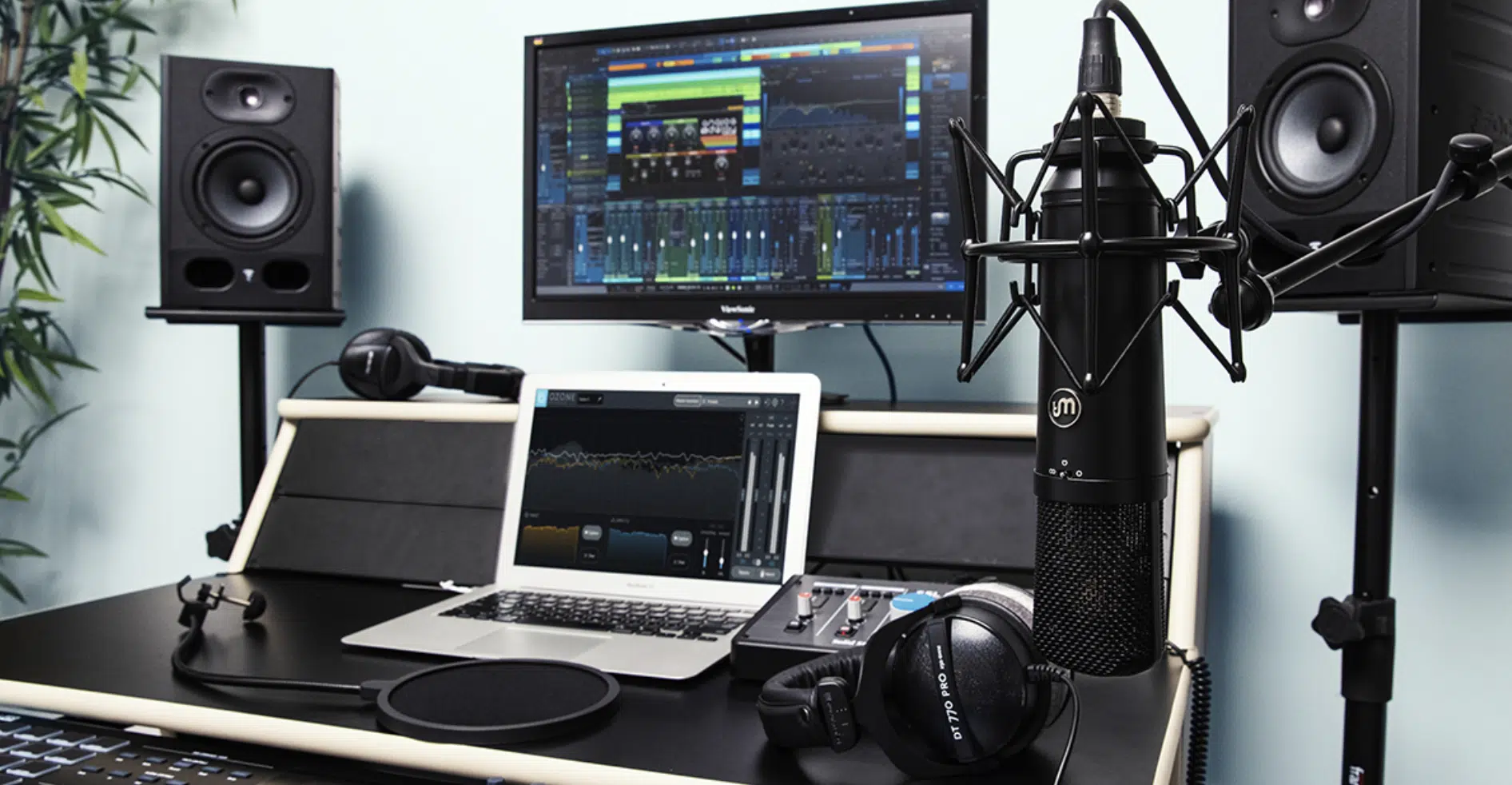
The quality of vocal recordings can elevate your track from amateur to professional, so investing in a good microphone (like a condenser microphone) is crucial.
Pop filters, though often overlooked, are also essential when you record vocals.
They reduce plosive sounds (like the “p” in “pop”) 一 ensuring a clean vocal recording.
When you record vocals, the environment matters too, as a home studio can produce high-quality recording if treated adequately for sound and set up for success.
NOTE: Basics like foam panels can reduce echo, making vocals crisp.
Lastly, headphones are vital when recording vocals.
Quality studio monitors allow you listen carefully to your vocals (in detail).
They help ensure no imperfections go unnoticed and can help you learn how to make music that includes killer vocals.
-
Vocal Manipulation: Getting Extra Creative
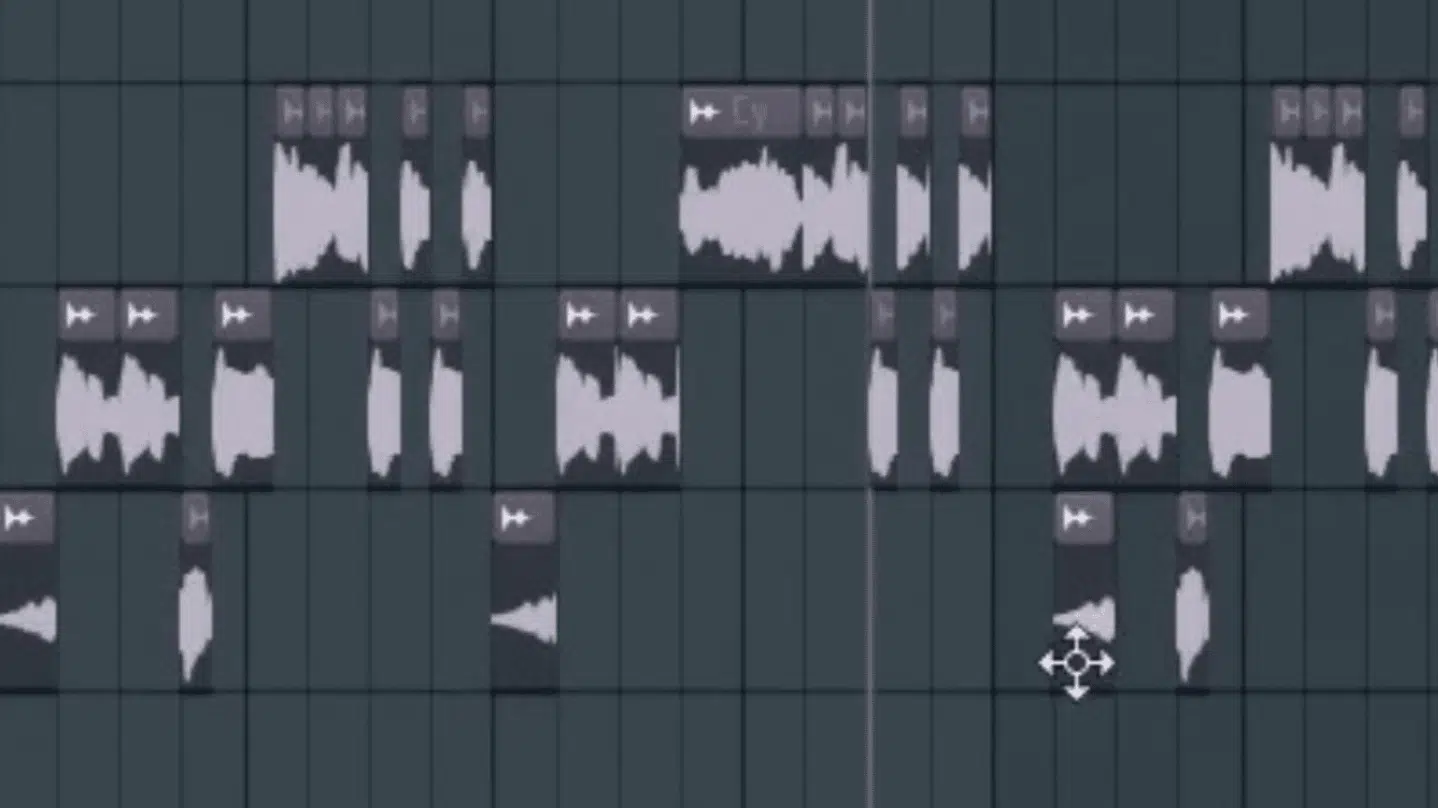
Once you’ve recorded vocals, the fun truly begins.
Vocal manipulation has become a hallmark of modern music production, especially in hip-hop and trap genres.
Using tools like Auto-Tune or Melodyne can drastically alter the character of vocals 一 turning them from raw recordings into unique instruments in their own right.
Layering is another essential technique in vocal production.
For example, you’re able to create a fuller, richer vocal sound simply by:
- Overlaying multiple vocal takes of the same line with variations
- Introducing harmonies and ad-libs
- Chopping, flipping, and screwing vocals creatively
You can successfully chop and screw vocals by slowing down the tempo and adding certain (desirable) chop effects.
This can create a psychedelic experience for the listener and get them hooked.
It’s a technique widely used by artists like Drake and Beyoncé to give their vocals a distinctive “choir-like” effect.
Reverb and delay effects are also indispensable.
They can add desired depth to vocals 一 making them resonate more with the listener.
NOTE: Make sure not to overdo it, as it can drown out your vocals and make them completely incoherent.
-
Fine-Tuning Your Vocals To Perfection

Mixing vocals is meticulous, ensuring they stand out yet blend seamlessly with the instrumental music.
Begin by equalizing or EQing your vocals.
EQ’ing your vocals removes any unwanted frequencies and helps vocals sit well in the mix.
For instance, cutting some low-end frequencies can prevent vocals from clashing with bass-heavy elements in hip-hop tracks.
Compression is next.
Compression helps even out the vocal dynamics, ensuring that louder and softer parts maintain consistency in volume.
When done correctly, your vocals will punch through the mix without overpowering other elements (which is crucial!).
Don’t forget about spatial plugins (like stereo wideners).
Spatial plugins can be used sparingly to give vocals a broader soundstage, enveloping them.
Just remember that it’s all about enhancing 一 not overshadowing any elements.
The final mix should sound harmonious, where vocals complement the beat, neither drowning nor being drowned out.
This balance is what distinguishes great music from the merely good.
Mixing and Mastering: Giving Your Track the Pro Touch
Behind every hit track is the invisible magic of mixing and mastering. So, let’s dissect this essential part of music production to enhance your workflow further.
-
Mixing: The Importance of Balanced Sound
A balanced mix ensures every element; from the booming kicks to the subtle hi-hats, has space in the sound spectrum.
It’s what makes a track sound full without sounding cluttered.
#1. Panning
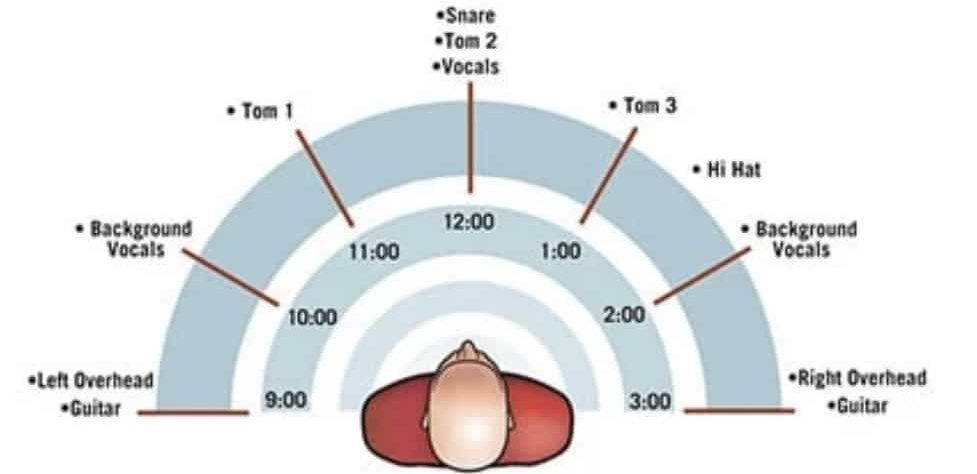
By assigning different instruments to different areas of the stereo field, you create space and prevent frequency clashes.
For instance:
- Main vocals 一 Typically sit at the center.
- Backing vocals or ad-libs 一 Can be panned slightly left/right for distinction.
Learning where to place different elements in the stereo field properly will help you avoid any unwanted noise, artifacts, or clipping.
#2. EQ
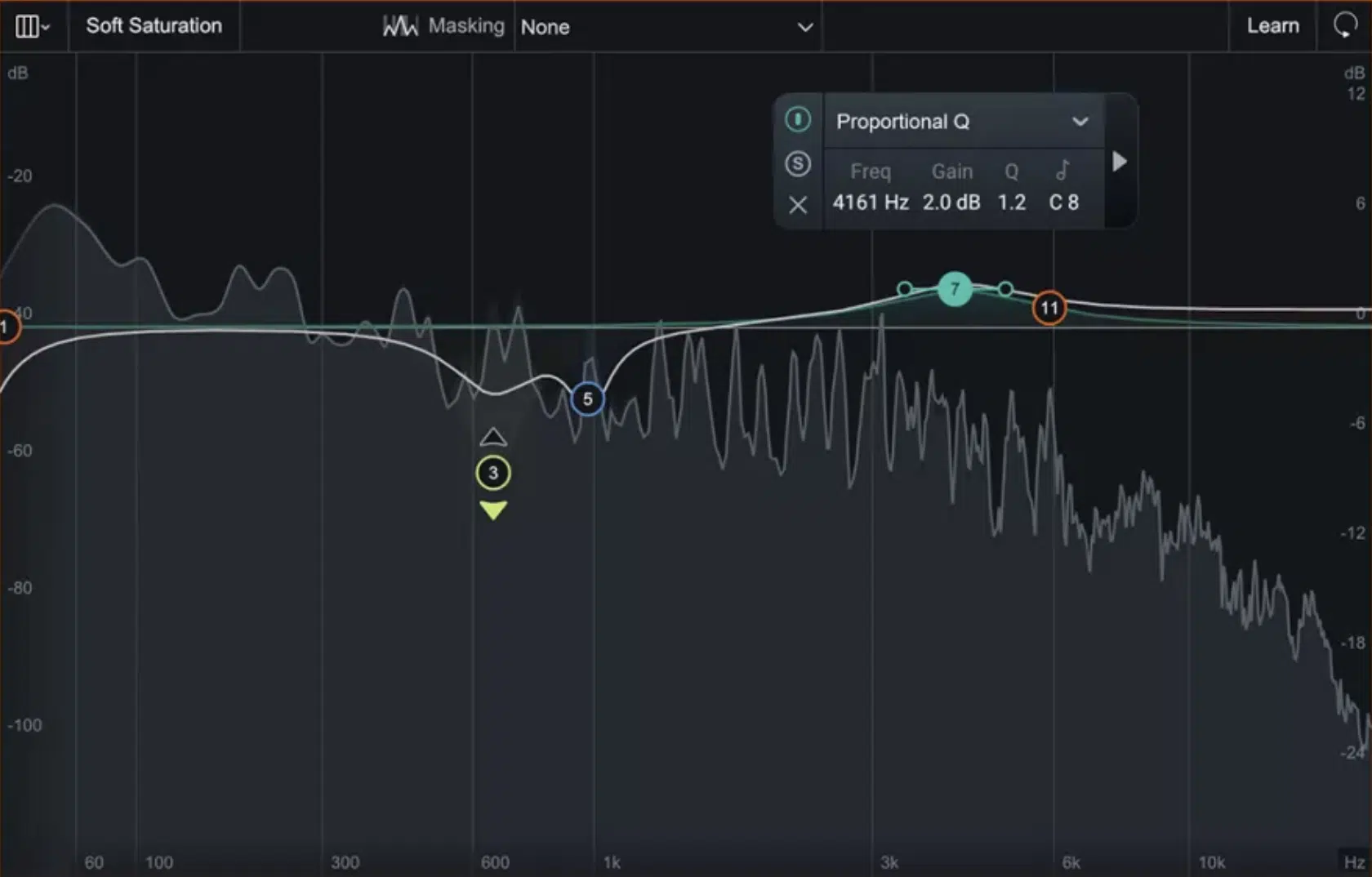
By carving out frequencies for each different software instrument, you ensure they don’t step on each other’s toes.
A common trick in hip-hop is cutting a small bass frequency range to let the kick drum punch through.
#3. Dynamic Processing
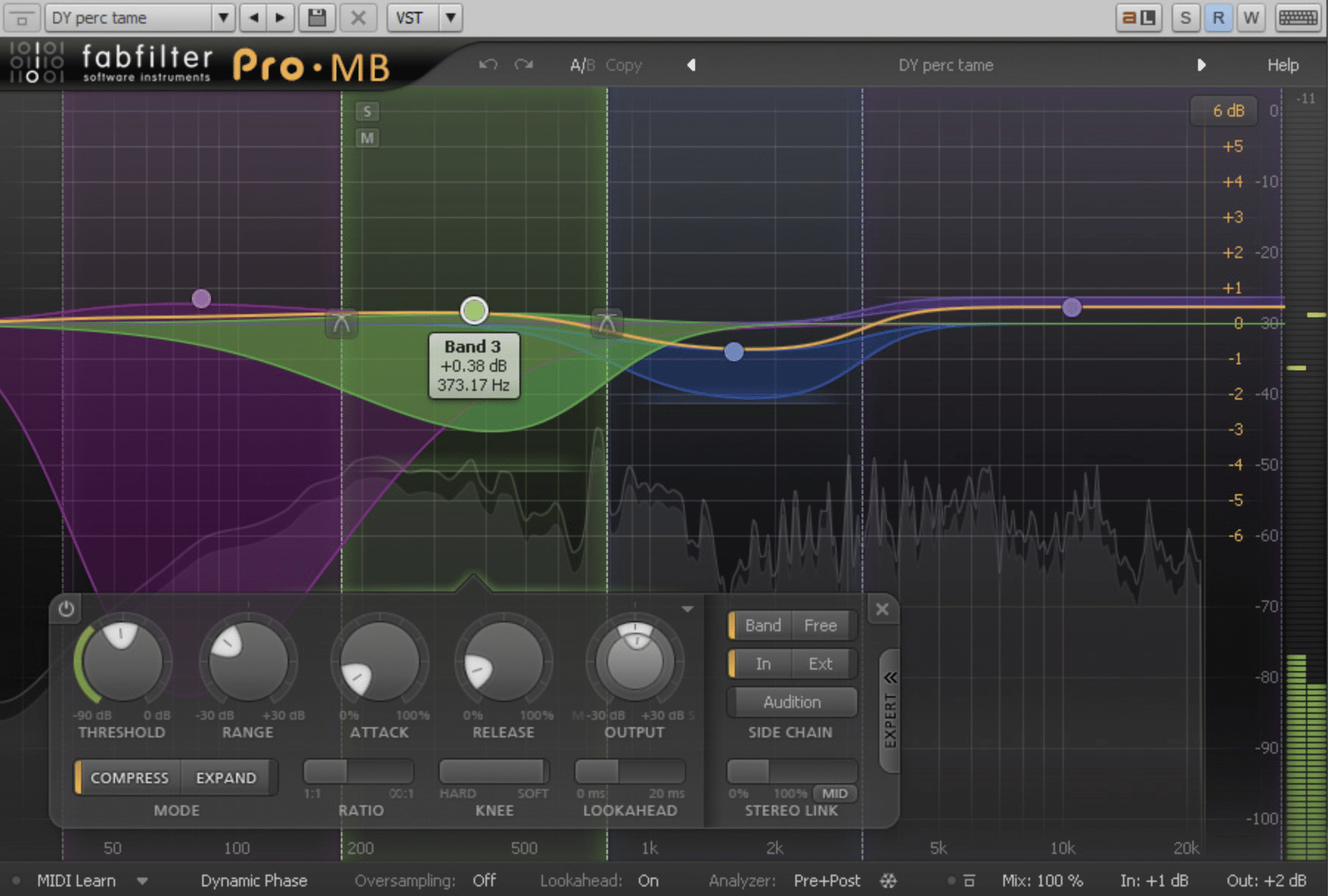
Dynamic processing, like compression and limiting, ensures the track maintains consistent energy.
It’s the glue that holds your mix together 一 making every element sound cohesive.
So, when you’re learning how to make music that shines and sounds professional, you do not want to skimp on the mixing section.
-
Sound Design: How To Make Music That Transcends
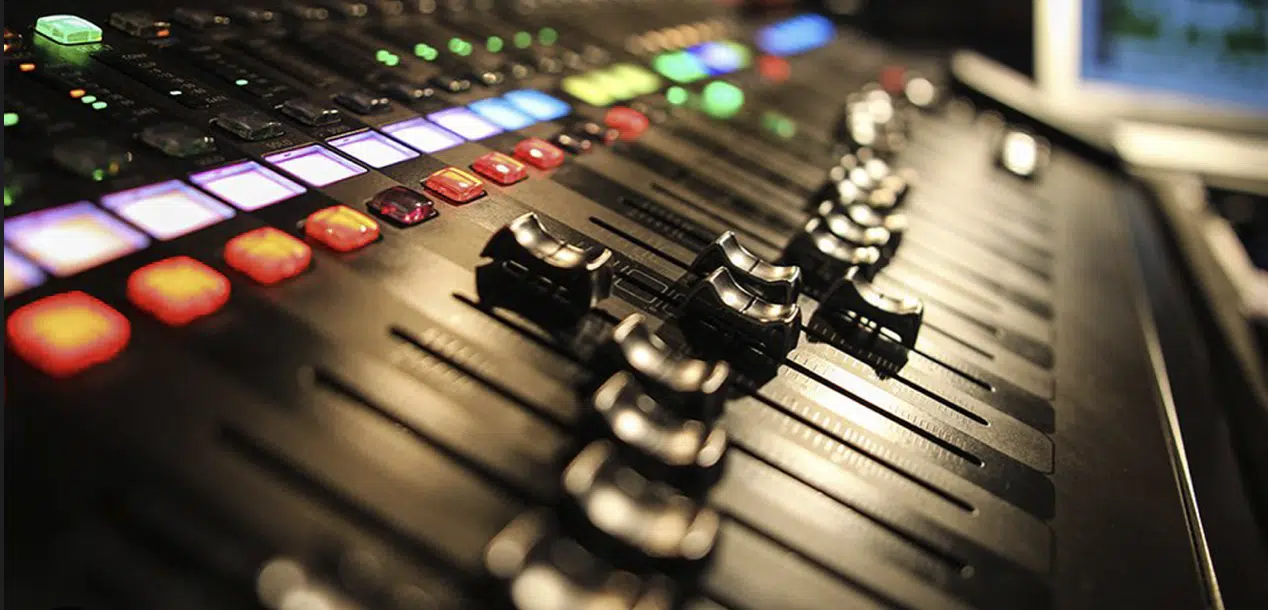
Sound design isn’t just for film or video games; it’s a crucial aspect of making music, especially in the digital realm.
It’s about sculpting and tweaking sounds to fit your vision.
When you produce music, this could mean crafting that perfect 808 bass or designing a unique snare that becomes your signature.
Software instruments and VSTs (Virtual Studio Technology) have made it more accessible for producers to dabble in sound design.
Layering is a powerful sound design tool here, as combining different sounds can result in something:
- Entirely new
- Intriguing
- Show-stopping and unique
For instance, layering a synthetic kick with a live kick can create a punchy sound with organic undertones.
Similarly, blending digital signals with recordings of live instruments can lead to epic hybrids.
When it comes to fine-tuning, automation is not to be overlooked 一 just look at your all-time favorite songs.
It allows for dynamic changes within the track, such as a filter sweep on a synth or a volume fade on a vocal ad-lib.
These minute details can elevate the overall quality of your music and ensure your track isn’t just good but great music.
-
The Mastering Process: Prepping for Streaming Platforms
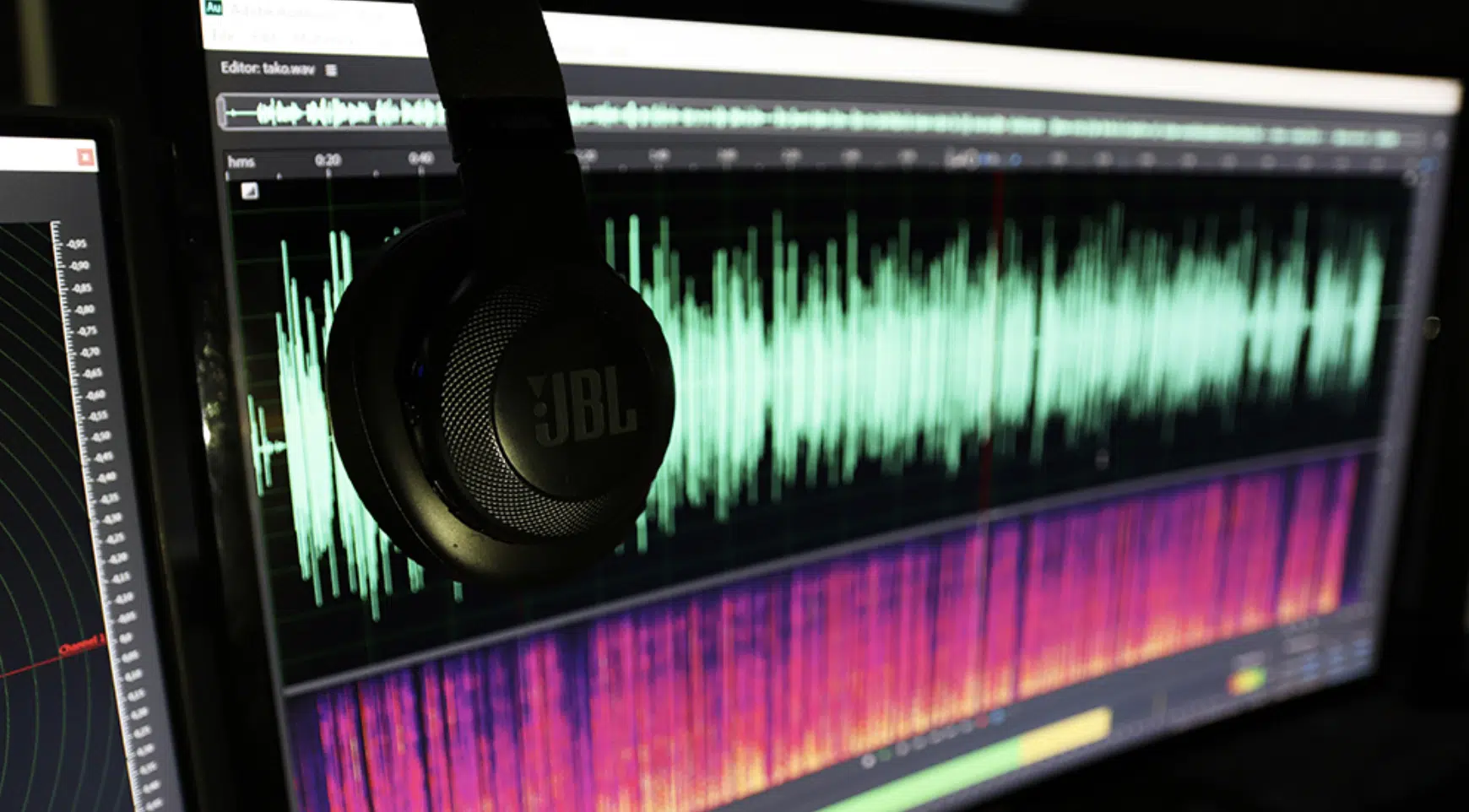
Mastering is often seen as the final polish to a finished track, the cherry on top.
In a world dominated by streaming platforms like Spotify and Apple Music, mastering ensures your track sounds its best on all devices (from studio monitors to earbuds).
At its core, mastering involves:
- EQ
- Compression
- Limiting
The goal is to achieve a balanced sound spectrum and to maximize loudness without causing distortion or clipping.
It’s also essential to consider the LUFS (Loudness Units Full Scale) standards set by each individual streaming platform.
For instance, Spotify currently has a -14 LUFS standard.
This ensures that all songs playback at a consistent volume 一 making sure your hip-hop track doesn’t sound too quiet.
NOTE: Don’t forget to always A/B test your masters.
Compare your mastered track to a similar track (reference track) by one of your favorite artists/producers in the same genre.
Every mastering engineer will tell you that it is super important if you want to produce good music consistently.
If your song can stand next to a hit track on a playlist and hold its own, you’re on the right path to learning how to make music that stands the test of time.
Bonus: Leveraging Streaming Platforms like Apple Music & Spotify
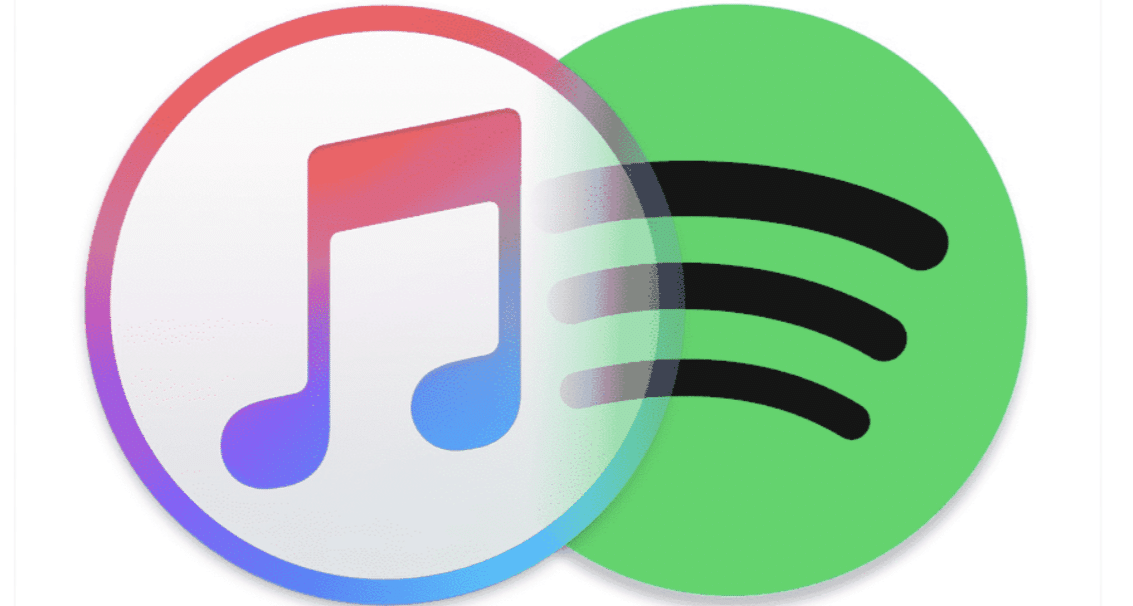
Streaming platforms have revolutionized how we consume music, whether you’re an artists or music producer.
Apple Music, with its vast user base, provides an excellent avenue for budding artists and producers to showcase their craft.
Before uploading to all the various streaming platforms, ensure your tracks are correctly metadata tagged.
This includes details like:
- The song title
- Artist/producer name
- Genre
Properly tagged tracks increase visibility during user searches 一 propelling your music to a broader audience.
Playlists are the golden ticket on platforms like Apple Music, as landing a spot on a popular playlist can skyrocket your plays.
So, always pitch your tracks to playlist curators or utilize third-party services that connect artists to playlists; it’s super beneficial.
Don’t forget to engage with your past and present listeners.
Respond to comments, share behind-the-scenes content, and offer insights into your music production journey.
When you’re learning how to make music, you must remember that connections can turn casual listeners into lifelong fans.
How to Make Music: Final Thoughts
Music production isn’t just about hitting some notes; it’s an art form that requires skill and soul.
From understanding the evolution of music to setting up your home studio, every step contributes significantly to your music production journey.
How to make music that resonates with listeners involves diving deep into music theory, crafting the perfect hip-hop beat, and mastering the art of mixing and sound design.
But remember, while techniques are vital, the true essence of how to make music that stands out lies in your unique touch.
Throughout our discussion, we’ve revealed many tips, tricks, and secrets seasoned producers use to craft hits.
But as you embark on your mission to figure out how to make music that leaves a lasting impression, or enhance your current beats, always remember the value of experimentation and authenticity.
To help further enhance your process and help you learn how to make music that blows your competition out of the water, you absolutely need this Free Dark Hip Hop Sample Pack.
This legendary pack offers over 60 free hip-hop samples, loops, and MIDIs tailor-made for crafting dark hip-hop beats.
If you want to add that signature dark flavor to your beats, ensuring they sound professional and placement-ready, this pack is your golden ticket.
Learning how to make music is a lifelong journey filled with constant growth, surprises, and immense satisfaction.
As you harness the power of the techniques and insights shared here, trust your instincts, be authentic, and never stop learning.
Because, at the end of the day, it’s all about making music that sounds good and feels right.
Until next time…







Leave a Reply
You must belogged in to post a comment.